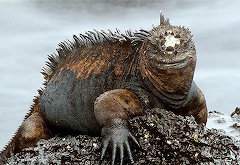TV special review: Galapagos (National Geographic Channel)
03/16/07 02:22 PM


By ED BARK
Soul stirring and breathtaking, National Geographic Channel's 3-hour Galapagos goes well beyond picturesque and into the realm of picture perfect.
Even better, it's presented in high-definition, doubling the pleasures of those with sets planted in TV's imminent future. Premiere night is Sunday, March 18, at 7 p.m. central (8 eastern). In a word, Galapagos is awesome. There, maybe that might lure a teen or 'tween or two.
Galapagos also is inspiring in its presentation of a pristine natural habitat of such splendor and longevity. For all the world's strip malls and land fills, there is still this. And the message imparted is clear: The islands made famous by naturalist Charles Darwin must remain unspoiled by humanoids of all races, colors and creeds.
Head cinematogropher Paul D. Stewart and crew shot more than 300 hours of HD footage over an 18-month period. Cameras range far and wide, covering the islands and their surroundings by air, at ground level and underwater, where the cameras really pop.
An early sequence shows a gnarly Marine iguana going deep to feed on its primary food, green and red algae. These pictures are stunning, as are the shots of blue-footed boobie birds mass "plunge-diving" into the ocean.
On land, meet the islands' giant tortoises, capable of weighing in at 600 pounds. See one of them rise up on all fours and stretch its neck so that a little finch can feed on it. That's the spirit.
As always in nature, there are predators, too. The Galapagos hawk is one of them, majestically zooming in for a kill on a scurrying female Marine iguana. It suffocates its victim by pressing its head into the hot sand. But the hawk also has other mouths to feed. Baby chick hawks easily can eat half an iguana a day, we're told by narrator Tom Hewitt.
Formed by exploding underwater volcanoes, the islands are ever-changing. Some have been around a very long time, though. The oldest of the 13 major islands, Espanola, supposedly was birthed some 3.5 million years ago. Still, nothing lasts forever. Espagnola soon is "destined to sink beneath the waves," says Hewitt.
Galapagos will stand the test of time. This is a stellar, signature achievement by National Geographic, which already has many beauty marks. It left this viewer almost moved to tears. Such beauty, such beasts. In a way we are not worthy. And that seems like the best way for all of us to keep looking at it.
Grade: A
|
